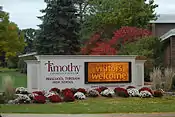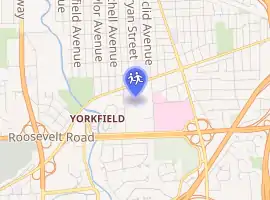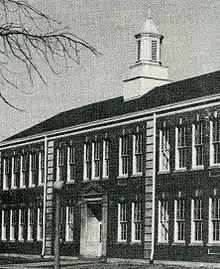Timothy Christian School (Illinois)
Timothy Christian School is a private, coeducational Christian school in Elmhurst, Illinois. It was founded in Chicago as a school for the children of Dutch immigrants in the area. It has moved twice in its history, following its Dutch students to Cicero before moving further west to Elmhurst.
| Timothy Christian Schools | |
|---|---|
 | |
| Location | |

| |
| , | |
| Information | |
| Type | Pre–12 |
| Motto | Beyond Belief |
| Religious affiliation(s) | Christian |
| Established | 1911 |
| Faculty | 91[1] |
| Enrollment | 365 in High School[2] |
| Campus type | Suburban |
| Color(s) | Red and White |
| Athletics conference | Metro Suburban Conference |
| Mascot | Trojans |
| Website | Timothy Christian Schools |
History
Chicago campus
The school began as a vision of several members of Douglas Park Christian Reformed Church. In April 1907, a Society for Christian Instruction was formed to explore the possibility of founding a school in the neighborhood known as the "Groninger Hoek."[3] After a year of growth, the society chose the name "Timothy" for their proposed school to honor the New Testament evangelist who had been raised in a Christian home and given spiritual instruction by the apostle Paul.[4] By August 1911, the society had raised enough funds to open the school. They did so above several retail establishments on Roosevelt Road on Chicago's west side.[4]
After a year in this building, the society purchased a lot on the corner of 13th street and Tripp Avenue, a few blocks away from the original premises. This lot was purchased for $1,500.[5] The school would remain in this building for only fifteen years, but in 1916, they received full accreditation from the Chicago Board of Education. The school continued to add rooms to the basement in order to accommodate more students. Initially, the school only served elementary students. By 1918, students were able to continue their education at Chicago Christian High School in the Englewood neighborhood.[3]
Much of the instruction of the students was undertaken in Dutch to help students maintain a link to their Dutch heritage. Very early, though, the school opened its doors to students of diverse nationalities and religious doctrines. By 1926, the school board made a resolution to maintain its minutes in English instead of Dutch. This also came at the same time that the school was paying off the last of its debt before the stock market crash of 1929 and before moving to a new location.[6]
Cicero campus

By 1927, the Dutch population had shifted from the west side of the city to the inner western suburbs of Chicago. As the families moved, so did their churches, and parents became less willing to send their children back to schools such as Timothy that remained in the old neighborhood.[7] Early in 1927, Timothy was able to sell its Tripp Avenue school building to a Jewish congregation, but were forced to vacate within six months. Work began on a new building almost immediately.[8] It was decided to build the new school in Cicero, Illinois because it was a central location to many of the families that had relocated west of the city of Chicago. The new school building opened in September 1927 with 156 pupils in four completed rooms on 14th Street.[7]
Disbanding Ebenezer School
The time in Cicero was marked by two crises for the school. The first was the integration of more than 100 students from Ebenezer Christian School in Chicago. As the Dutch Christian Reformed communities had fled the city for the suburbs, Ebenezer became impossible to keep open. This had been the first Dutch reformed school to open on Chicago's west side in 1893. It closed in 1946, and the huge influx of students to Timothy caused a great deal of tension. Students were forced to endure large class sizes and little time alone with the teachers.[9] There was also the problem of social integration of a suburban student body with one hailing from the tough streets of Chicago.[7]
Timothy-Lawndale controversy
The integration of the students from Ebenezer Christian School was far easier to deal with than the racial integration of the school. In 1965, a group of African American parents attending Lawndale and Garfield Christian Reformed Churches asked the Timothy board permission to enroll their children at the school.[10] Cicero was, at the time, a town with around 70,000 residents of European descent and had earned the reputation as the “Selma of the North.”[7] One black family had attempted to move into the city in 1951 and they had been chased out by a white mob.[7] The Timothy school board decided to delay the enrollment of these students. The board insisted that it was not acting on racist motives, but only that it was worried for the safety of its students. The school only admitted three African American students in 1967 after Timothy Christian High School had moved to the western suburb of Elmhurst.[7]
The matter quickly escalated into an ecclesiastical matter as the Christian Reformed Church got involved. The school was not a parochial school, being run by an independent society, but its close relationship with the church brought protesters from all over the country. A large contingent from Calvin College, the Christian Reformed college in Grand Rapids, Michigan arrived in 1969 wearing black arm bands in solidarity with the protesters. Several teachers at the school also resigned in protest.[11]
Government agencies also became involved due to the racial component of the struggle. As Cicero residents continued to harass the school and church members continued to advise against integration, Timothy decided to wait until it could complete the move to a campus in a more racially tolerant suburb. This move to Elmhurst was finally made in 1972. In the meantime, the parents of Lawndale and Garfield Christian Reformed Churches had established their own school, West Side.[7]
Elmhurst campus
The move to a new campus had begun in 1962 when Timothy Christian established its high school in Elmhurst. It continued with a middle school in 1970. By 1972, the elementary school joined the other two components on a 26-acre (110,000 m2) campus.[12] In the 1970s, the school saw a sharp enrollment decline, before an increase in the 1980s as more parents moved farther west and out of Berwyn and Cicero. In this new location, the school's student body has gradually become less Dutch and less Reformed. The school still occupies the campus on the south side of Elmhurst on Butterfield Road with about 1200 students attending. The high school enrollment is about 400. The school offers numerous extracurricular activities including boys and girls athletics, dramas, academic teams, choral, orchestral, and symphonic ensembles.[13]
Notable alumni
References
| Wikimedia Commons has media related to Timothy Christian School. |
- "Timothy Christian Schools–Alphabetical Staff Directory". Timothy Christian Schools. n.d. Retrieved 2007-04-30.
- "Timothy Christian Schools–Demographic/Diversity Information". Timothy Christian Schools. n.d. Retrieved 2007-04-30.
- Swierenga, Robert P. (2002). Dutch Chicago: A History of the Hollanders in the Windy City. Grand Rapids, MI: Eerdmans (The Historical Series of the Reformed Church in America). pp. 383–395. ISBN 0-8028-1311-9.
- History of the Timothy Christian School Society. Cicero, Illinois: Timothy Christian Schools. 1936. p. 7.
- Timothy Christian School 50th Anniversary, 1911-1961. Cicero, Illinois: Timothy Christian Schools. 1961. pp. 1–4.
- Swierenga, Robert P. (2002). Dutch Chicago: A History of the Hollanders in the Windy City. Grand Rapids, Michigan: Eerdmans (The Historical Series of the Reformed Church in America). pp. 422–442. ISBN 0-8028-1311-9.
- Timothy Christian School 50th Anniversary, 1911-1961. Cicero, Illinois: Timothy Christian Schools. 1961. pp. 5–8.
- Stulp, Martin (September 1999), "Reminiscences, 1949 Timothy Class 50th Reunion, Frankfort, Illinois", The Timothy Reflector: 26.
- Meehan, Christopher (1996). Flourishing in the Land: A Hundred-Year History of Christian Reformed Missions in North America. Grand Rapids, Michigan: Eerdmans. p. 135137.
- "4 Teachers Quit; Cicero School Shut", Chimes: 7, 24 October 1969.
- Swierenga, Robert P. (2002). Dutch Chicago: A History of the Hollanders in the Windy City. Grand Rapids, Michigan: Eerdmans (The Historical Series of the Reformed Church in America). pp. 443–446. ISBN 0-8028-1311-9.
- "Timothy Christian Schools–Timothy at a Glance". Timothy Christian Schools. n.d. Retrieved 2007-04-30.